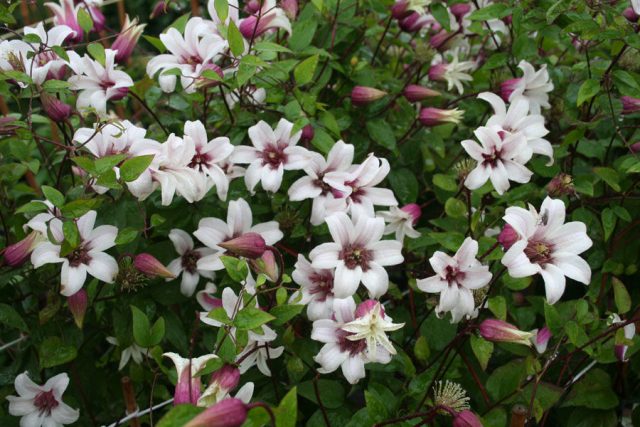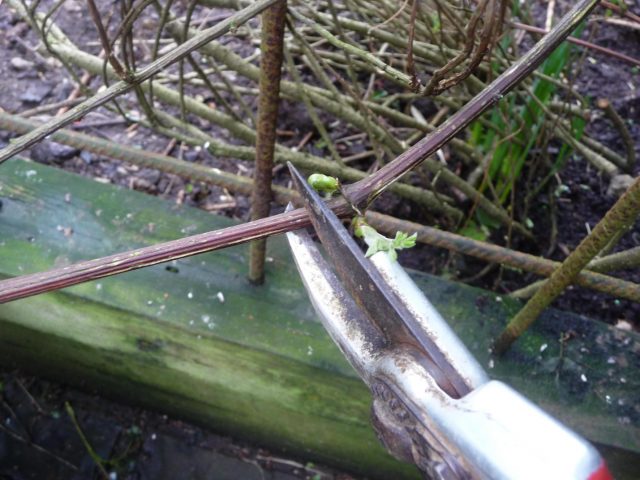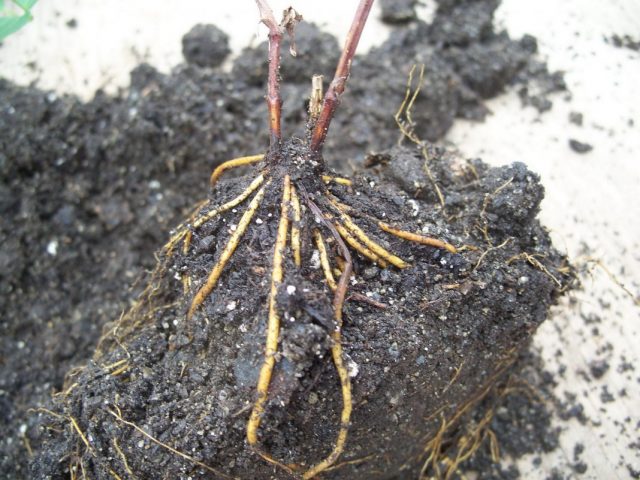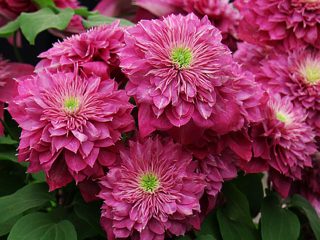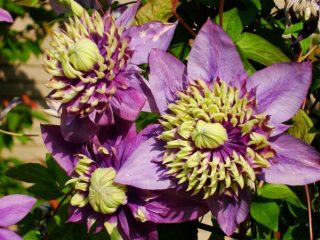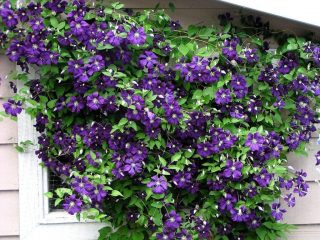Content
Clematis Princess Keith was bred in Holland in 2011 by J. van Zoest BV. Clematis of this variety belong to the Texas group, the pruning of which is considered to be the maximum.
Description of Clematis Princess Kate
According to the description, Clematis Princess Kate (shown in the photo) has small urn-shaped flowers that change during flowering and resemble bells.
The flower petals are white on the inside, the base is reddish-violet, the outside is purple. Filaments in flowers are pale purple, anthers are darker, reddish purple.
The diameter of the flowers is small, the indicator ranges from 4-6 cm. The width of the petals is not more than 2.5 cm, the length is up to 5 cm. The shape of the flower petals is ovate-lanceolate, the ends are slightly bent outward. Fleshy petals, found on top of each other.
Princess Kate blooms from June to September. The flowering is profuse and long lasting. Flowers are formed on young shoots of the current year. In autumn, the plant is decorated with decorative seedlings.
The height of the shoots of this variety ranges from 3 to 4 m.
Clematis Princess Kate is a perennial plant. Both sunny and periodically shaded areas are suitable for planting it. Ornamental shrubs are used to decorate arbors, arches, trellises, fences.
Clematis belongs to a fairly frost-resistant crop, Princess Kate tolerates frosts down to -29 ° C.
Clematis trimming group Princess Kate
In autumn, pruning is carried out in the cold period, but it is necessary to have time before the frost begins. In the first autumn after planting, clematis of all varieties are cut off in the same way, leaving 20-30 cm above the ground at one of the strongest shoot. This procedure helps the formation of side shoots in the spring. Further, pruning is carried out depending on which group the clematis belongs to. Princess Kate blooms on young shoots that have formed in spring. Clematis that bloom in this way belong to the third pruning group.
Correct pruning consists in removing all shoots at a height of 10-15 cm from the ground, it must be taken into account that at least 2-3 buds should remain on the branches.
Planting and caring for clematis Princess Kate
Clematis Princess Kate belongs to light-loving plants, therefore, sunny or periodically shaded places are chosen for planting, but the plant should be in the sun for at least 6 hours a day. Clematis do not tolerate the wind well, the area with clematis must be protected from drafts. The best option for planting is the southern, southwestern or southeastern section of the garden.
The soil on the site should be fertile and loose, loams are best suited, but excessively saline, acidic and heavy soils for cultivation are unacceptable.
Flowers are planted in spring or autumn. Before that, you need to take care of installing the support. Since the length of clematis lashes reaches 3-4 meters, the support should be at least 2-2.5 m.
Supports should not be installed in close proximity to the wall of the building, since water flowing down from the roof in spring or autumn will lead to decay of the plant root system and its death.
Before planting, the roots of the plant must be soaked in water for several hours, you can add a means to accelerate growth.
The landing hole is prepared in advance. A mixture is added to it, consisting of the following components:
- humus - 1 part;
- sand - 1 part;
- garden land - 1 part;
- wood ash - 0.5 l;
- complex fertilizers - 100 g.
The nutrient mixture is poured into the pit with a slide, a seedling is placed on top and its roots are straightened. They cover it with soil, carefully pressing the ground with your hands so that the seedling does not fall in the hole when watering. Clematis is watered and the pit is covered with a layer of mulch.
Before rooting, the seedling is shaded. In addition, it is advisable to fill the root circle with annual or perennial plants with a shallow root system; a green carpet of marigolds, phloxes, chamomiles will protect the roots of clematis from overheating.
Caring for Clematis Princess Kate consists of carrying out the following activities:
- watering. It is not recommended to fill the seedling, but watering should be abundant;
- fertilization. After planting, clematis does not need feeding. Fertilizers applied to the planting hole provide the plant with all the necessary substances throughout the year. The next year after planting and then annually in the spring, nitrogenous compounds are applied, during the period of bud appearance - mineral fertilizers, and after flowering (at the end of August) - phosphorus and potassium;
- the plant is pruned annually;
- pinching of the top is necessary to stimulate shoot formation;
- a growing liana requires a garter to a support, therefore, the tying procedure is periodically carried out;
- disease prevention. The soil before planting is treated with 0.1% Fundazol solution. The treatment is repeated after 2 weeks.
Reproduction
There are several methods for breeding clematis:
- from seeds;
- using layering;
- cuttings;
- dividing the bush.
The Princess Kate variety is most conveniently propagated by dividing an adult bush. For this, plants are used that have reached 5-6 years old and have numerous shoots. This method allows you to get clematis blooming in the year of separation.
The autumn division of the bush is preferable, but if it was not possible to carry out the procedure, then the procedure can be performed in early spring, when the snow has gone and the soil has melted, but the buds have not yet blossomed. It is very important not to miss this moment, since division at a later date can lead to the death of the plant.
Separation process technology:
- planting pits should be watered abundantly with water mixed with a growth stimulant;
- during the autumn division, the aerial part is pruned, leaving 3 pairs of buds on the shoots;
- rhizomes are carefully dug up with a large clod of earth;
- shaking off the earth, the roots are immersed in water and washed so that their structure becomes clear;
- the roots are divided in such a way that at least 3 shoots with visible renewal buds remain on each;
- the maximum number of divisions is 3;
- after dividing, the roots of each seedling are examined, damaged areas are removed;
- to prevent infection, the rhizomes are soaked in a solution of manganese or a fungicidal preparation;
- plants are planted in compliance with planting requirements.
It is possible to divide the bush without completely digging it up. To do this, dig in the roots on one side of the bush and manually shake off the earth from them. With a garden tool (pruning shears or scissors), shoots with roots are cut off, the rest of the bush is buried and watered. The separated bush is transplanted to a new location.
Diseases and pests
Clematis Princess Kate may suffer from the following diseases: wilting, gray mold, powdery mildew, rust, Alternaria, Septoria. With powdery mildew, a copper-soap solution is used, which is sprayed with shoots. Gray rot and drying out is treated with Fundazole solution. Copper-containing agents are used against rust, Alternaria, Septoria.
Of the pests, the greatest danger to clematis is spider mites, aphids and slugs. Fitoverm solution will help get rid of aphids. You can dilute green soap and wipe the foliage with this liquid. Acaricidal agents are used to combat spider mites.
Slugs are disposed of manually or sprayed with ammonia diluted in water (for 1 liter of water - 2 tablespoons of ammonia).
Conclusion
Clematis Princess Kate is a great choice for garden decoration. The plant is used to decorate gazebos, trellises, fences. By following the care recommendations, you can achieve long flowering.
